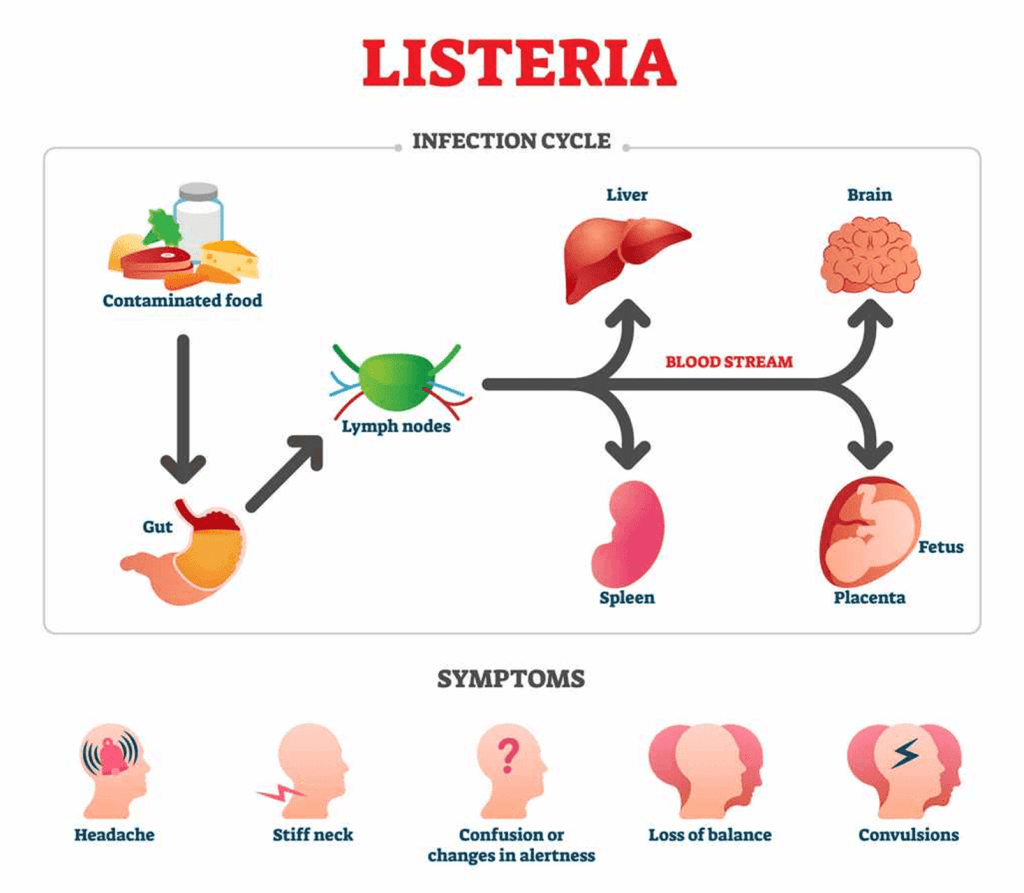Ice is widely used in beverages, food preservation, and medical applications. However, many people mistakenly assume that it is sterile. Research, however, shows that ice can harbour bacteria capable of surviving freezing temperatures. Freezing is a commonly used method for food preservation. However, harmful bacteria like Escherichia coli (E. coli), Salmonella spp., and Listeria monocytogenes can survive in these frozen conditions (Ding et al., 2024). Once thawed, these bacteria reactivate, posing serious health risks, especially to pregnant women, children, the elderly, and the immunocompromised. The World Health Organisation (WHO) reports that unsafe food causes about 600 million foodborne illnesses and 420,000 deaths annually. Children under five account for 30% of these fatalities (WHO, n.d.).

Source: TwiceTheIce
What Happens to Bacteria in Freezing Temperatures?
Freezing food slows down bacteria, but it does not always kill them (Erkmen & Bozoglu, 2016). Some bacteria, like Listeria monocytogenes and Salmonella, can survive and multiply when food is thawed. Freezing puts bacteria in a dormant state rather than destroying them completely. When food is thawed at improper temperatures, bacteria become active again, potentially causing contamination and illness.
Some bacteria form spores to survive extreme temperatures. These spores can germinate when conditions become favourable, such as during thawing. This leads to bacterial growth. Proper food handling during freezing, thawing, and cooking is essential to prevent foodborne illnesses. Following correct freezing techniques and hygiene measures minimises these risks.

Source: IMD
Common Bacteria Found in Frozen Foods
Some of the most dangerous bacteria found in frozen foods include:
- Listeria monocytogenes: Can grow even in cold temperatures and cause severe illness, particularly in pregnant women, newborns, and elderly individuals (Marc, 2020).
- Salmonella: Can survive freezing and cause food poisoning, leading to symptoms such as diarrhea, fever, and abdominal cramps (Mohammed and Majeed, 2020).
- Escherichia coli (E. coli): Can lead to serious stomach infections, and in severe cases, may result in hemolytic-uremic syndrome (affects the kidneys) or other life-threatening complications (Aljamali et al., 2021).
- Clostridium botulinum: Produces a toxin that can cause botulism, a rare but serious illness that affects the nervous system (Kanaan & Tarek, 2020).

Symptoms and infection cycle of Listeria.
Source: Food Safety Training and Certification
Bacteria are often linked to frozen products such as ready-to-eat meals, frozen vegetables, seafood, poultry, and meat. Improper storage, handling, and cooking of these foods significantly increase the risk of foodborne illness. Contaminated frozen food can carry disease, making proper food safety measures vital.
Why These Bacteria Are Dangerous
Each of these bacteria poses a significant health risk. For example, Listeria can lead to severe infections and even death in vulnerable individuals. Pregnant women are particularly at risk, as Listeria infections can result in miscarriage, stillbirth, or serious illness in newborns (Valenti et al., 2021).
Similarly, Salmonella is a leading cause of foodborne illnesses worldwide, with symptoms ranging from mild stomach discomfort to severe dehydration requiring hospitalisation. Meanwhile, E. coli outbreaks have been linked to frozen food products such as beef and leafy greens, often causing severe stomach infections. According to the Centers for Disease Control and Prevention (CDC), Clostridium botulinum, on the other hand, produces a potent neurotoxin that can cause paralysis, respiratory failure, or death if left untreated (Rao et al., 2021).
Given these risks, it is essential to take proactive measures to prevent contamination at every stage, from food production to consumption. Everyone, from regulatory bodies to individuals, plays a role in ensuring food safety.
Health Risks Associated with Bacteria in Cold Chain Foods
Consuming contaminated frozen foods can lead to severe health complications, particularly for vulnerable populations such as pregnant women, young children, the elderly, and immunocompromised individuals. Listeria infections can result in miscarriage, stillbirth, and serious illnesses (CDC, 2025). Meanwhile, E. coli and Salmonella infections can cause gastrointestinal distress, kidney failure, and, in severe cases, death.
Listeria monocytogenes is particularly cold-tolerant and can survive in frozen seafood and vegetables. A study conducted in Portugal found that 14.8-22.6% of frozen vegetable samples tested positive for this pathogen (Kataoka et al., 2017). When these foods are thawed, the bacteria can resume growth, which significantly increases health risks. This highlights the importance of proper thawing and handling to prevent potential foodborne illnesses.

A picture of frozen foodstuff.
Source: LiveMint
How Freezing Affects Bacteria: A Scientific Perspective
While freezing significantly reduces bacterial growth, it does not guarantee complete eradication. Certain bacteria develop resistance mechanisms, enabling them to survive extreme cold. Researchers continue to investigate how bacteria adapt to frozen environments, allowing for the development of innovative food safety interventions. Understanding these survival mechanisms is key to enhancing frozen food preservation techniques and minimising contamination risks (Shen et al., 2021).
Psychrophilic microorganisms are cold-loving; they employ cold-adaptive proteins, including cold-shock proteins and antifreeze proteins, to counteract the damaging effects of freezing temperatures (Jin et al., 2022). Bacteria undergo physiological changes in response to freezing. Ice crystal formation can damage cell membranes, but some microbes produce protective substances to withstand freezing conditions (Pin et al., 2025).
Safer Ways to Store Frozen Foods: Food safety
Proper storage can prevent bacteria in frozen foods from growing. To achieve this, follow these frozen food safety tips:
- According to El-Kest & Marth (1992), food kept frozen at -18°C or lower can prevent bacterial growth and maintain cold storage food safety.
- “Discard any perishable food (such as meat, poultry, fish, eggs, and leftovers) that have been above 40°F for 2 hours” (Stewart & Stewart, n.d).
- Do not refreeze thawed food, as this increases bacterial activity and contamination risks. Freeze-thaw cycles increased the microbial counts (Mohammed et al., 2021; Ahmed & Marzany, 2022).
- Store food in airtight containers to prevent cross-contamination with other foods (Mahunu et al., 2024; Madhwal & Sharma, n.d.).
- Label frozen foods refrozen and/or with storage dates to ensure they are consumed before quality deteriorates, reducing foodborne illness risks (Garden-Robinson, 2013).
- Keep freezers clean and maintain them at the recommended temperature settings to support frozen bacteria survival prevention (Madhwal & Sharma, n.d.).
By following these guidelines, consumers can minimise the risk of bacterial growth in their frozen food. This helps maintain food quality for longer periods, ensuring safer handling and preventing bacteria in frozen foods.
The Right Way to Thaw Food
Thawing food incorrectly can allow bacteria to multiply. To avoid this, safe thawing methods include:
- Refrigerator thawing: Thaw food at 4°C; this requires planning, as it takes longer than thawing at room temperature (Koc et al., 2025).
- Cold water thawing: Faster than refrigeration, but it requires the food to be in a leak-proof bag and the water to be changed every 30 minutes (Sivakumar, n.d).
- Microwave thawing: Quick, but should be followed by immediate cooking to prevent bacteria from multiplying (Koc et al., 2025).
- Cooking without thawing: Some frozen foods, such as vegetables, can be cooked directly without thawing to maintain safety and nutrients (EatRight, 2020).
As a result, choosing the right thawing method is crucial in maintaining food safety and preventing bacterial growth. For further guidance on safe thawing methods, refer to USDA Food Safety and Inspection Service here.
Store food safely by knowing which foods to refrigerate or freeze, following the recommended temperatures, tracking how long they stay fresh, and recognising when freezing isn’t suitable. For more details, visit the FoodSafety.gov.
Conclusion: Safeguarding Ice for a Healthier Tomorrow
Bacteria in ice pose a hidden but significant public health threat. While freezing slows microbial activity, it does not eliminate all pathogens. Contaminated ice can spread bacteria, leading to foodborne illnesses. Research highlights the importance of understanding how bacteria survive in freezing conditions and their potential impact on health. By adopting strict ice hygiene practices, we can reduce health risks. Proper storage, prevention of cross-contamination, and public awareness are key to minimising the risks associated with ice-borne bacteria. Ultimately, safeguarding ice hygiene is essential for a healthier future.
Call to action
To protect public health and ensure food safety, it’s crucial to prioritise proper ice hygiene and handling practices. Regularly clean ice-making equipment, store ice in safe conditions, and educate your community about the risks of contaminated ice. Together, we can reduce the spread of harmful bacteria and prevent foodborne illnesses. Take action now by implementing safer ice practices in your home, workplace, and community. A healthier tomorrow starts with smarter choices today.
Achieving the UN Sustainable Development Goals (SDGs)
The topic of bacteria in ice aligns with several Sustainable Development Goals (SDGs), particularly SDG3: Good Health and Well-Being, as it addresses the health risks posed by ice-borne pathogens, which can lead to foodborne illnesses, especially among vulnerable populations. It also connects to SDG2: Zero Hunger, by promoting safer food handling and storage, which is crucial for food security. SDG12: Responsible Consumption and Production is relevant, as responsible practices in ice production and storage can reduce contamination risks, supporting sustainable food safety systems. Furthermore, SDG6: Clean Water and Sanitation emphasises the importance of clean water in ice production, ensuring safe consumption. Lastly, SDG13: Climate Action is linked, as climate change accelerates glacier melting, reactivating ancient microbes, which may pose new health risks (Charlier et al., 2020). Addressing these issues contributes to healthier communities and supports long-term sustainability goals.
A Thrivable Framework
THRIVE Project is a non-profit organisation addressing global issues using twelve Foundational Focus Factors (FFFs) to promote thrivability. The topic of bacteria survival in freezing temperatures aligns with key principles of the THRIVE Framework. It connects to Systems Thinking (STH), considering factors like microbial behavior, food safety, and environmental conditions. The issue also links to Finite Resources (FRE), as ice production and cold storage rely on water and energy. Additionally, the persistence of harmful bacteria in cold environments is a Complex Wicked Problem (CWP) requiring solutions across sectors. It also aligns with Science-Based Targets (SBT), aiming to reduce bacterial contamination in frozen foods. Ensuring safe food-handling practices supports the Regenerative Economy (REC), fostering sustainability. Stay engaged to guide evolutionary engineering in an ethical, inclusive, and Thrivable direction. .
To learn more about our work, visit our website and explore how we’re making a difference. You can also follow our informative blog and podcast series, where you can dive deeper into the latest sustainability topics. Join our live webinars, where expert guests from various fields share valuable insights and answer your questions in real time. Sign up for our newsletter to stay up-to-date with upcoming events, fresh content, and exclusive opportunities. Watch our YouTube videos, explore our journal and whitepapers, or connect with us on LinkedIn.























